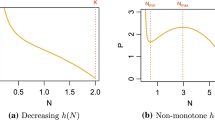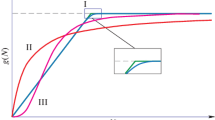Abstract
In theory, enrichment of resource in a predator-prey model leads to destabilization of the system, thereby collapsing the trophic interaction, a phenomenon referred to as “the paradox of enrichment”. After it was first proposed by Rosenzweig (1971), a number of subsequent studies were carried out on this dilemma over many decades. In this article, we review these theoretical and experimental works and give a brief overview of the proposed solutions to the paradox. The mechanisms that have been discussed are modifications of simple predator-prey models in the presence of prey that is inedible, invulnerable, unpalatable and toxic. Another class of mechanisms includes an incorporation of a ratio-dependent functional form, inducible defence of prey and density-dependent mortality of the predator. Moreover, we find a third set of explanations based on complex population dynamics including chaos in space and time. We conclude that, although any one of the various mechanisms proposed so far might potentially prevent destabilization of the predator-prey dynamics following enrichment, in nature different mechanisms may combine to cause stability, even when a system is enriched. The exact mechanisms, which may differ among systems, need to be disentangled through extensive field studies and laboratory experiments coupled with realistic theoretical models.
Similar content being viewed by others
References
Abrams P A 1994 The fallacies of “ratio-dependent” predation; Ecology 75 1842–1850
Abrams PA and Walter C J 1996 Invulnerable prey and the paradox of enrichment; Ecology 77 1125–1133
Abrams P A 2000 The evolution of predator-prey interactions; theory and evidence; Annu. Rev. Ecol. Syst. 31 79–105
Abrams P A 2002 Will declining population sizes warn us of impending extinctions?; Am. Nat. 160 293–305
Abrams P A and Ginzburg L R 2000 The nature of predation: prey dependent, ratio dependent or neither?; Trends Ecol. Evol. 15 337–341
Arditi R and Ginzburg L R 1989 Coupling in predator-prey dynamics: ratio-dependence; J. Theor. Biol. 139 311–326
Arditi R and Berryman A A 1991 The biological-control paradox; Trends Ecol. Evol. 6 32
Bartosz G 2005 Food toxicity contributes to the beneficial effects of calorie restriction; J. Theor. Biol. 233 451–452
Bazykin A D 1974 Volterra’s system and the Michaelis-Menton equation. Problems in mathematical genetics. (Novosibirsk, Russia: USSR Academy of Sciences, pp 103–142)
Bernstein C 1981 Dispersal of Phytoseiulus persimilis [Acarina: Phytoseiidae] in response to prey density distribution. D.Phil. Thesis, Oxford University
Calbet A, Broglio E and Saiz et al 2002 Low grazing impact of mesozooplankton on the microbial communities of the Alboran sea: a possible case of inhibitory effects by toxic dinoflagellate Gymnodinium catena-tum; Aquat. Microb. Ecol. 26 235–246
Chattopadhyay J, Sarkar R R and Mandal S 2002 Toxin-producing plankton may act as a biological control for planktonic blooms—field study and mathematical modelling; J. Theor. Biol 215 333–344
Diehl S, Lundberg P A, Gardfjell H, Oksanen L and Persson L 1993 Daphnia-phytoplankton interactions in lakes: is there a need for ratio-dependent consumer-resource models?; Am. Nat. 142 1052–1061
Dietrich C G, Geier A and Oude Elferink R P 2003 ABC of oral bioavailability: transporters as gatekeepers in the gut; GUT 52 1788–1795
Flynn K J, Davidson K and Cunningham A 1996 Prey selection and rejection by microflagellate; implications for the study and operation of microbial food webs; J. Exp. Mar. Biol. Ecol. 196 357–372
Fryxell J M and Lundberg P 1998 Individual behavior and community dynamics (London: Chapman and Hall)
Fussmann G F, Ellner S P, Shertzer K W and Hairston N G 2000 Crossing the Hopf bifurcation in a live predator-prey system; Science 290 1358–1360
Fussmann G F and Blasius B 2004 Community response to enrichment is highly sensitive to model structure; Biol. Lett., doi: 10.1098/rsbl.2004.0246.
Gatto M 1991 Some remarks on models of plankton densities in lakes; Am. Nat. 137 264–267
Genkai-Kato M and Yamamura N 1999 Unpalatable prey resolves the paradox of enrichment; Proc. R. Soc. London B 266 1215–1219
Genkai-Kato M and Yamamura N 2000 Profitability of prey determines the response of population abundances to enrichment; Proc. R. Soc. London B 267 2397–2401
Gleeson S K 1994 Density dependence is better than ratio dependence; Ecology 75 1834–1835
Grover J P 1995 Competition, herbivory, and enrichment: nutrient-based models for edible and inedible plants; Am. Nat. 145 746–774
Harrison G W 1995 Comparing predator-prey models to Lukinbill’s experiment with Didinium and Paramecium; Ecology 76 357–374
Holyoak M 2000 Effects of nutrient enrichment on predator-prey metapopulation dynamics; J. Anim. Ecol. 69 985–997
Huffaker C B, Shea K P and Herman S G 1963 Experimental studies on predation: complex dispersion and levels of food in an acarine predator-prey interaction; Hilgardia 34 305–330
Jansen V A A 1995 Regulation of predator-prey systems through spatial interactions: a possible solution to the paradox of enrichment; Oikos 74 384–390
Jansen VAA 2001 The dynamics of two diffusively coupled predator-prey populations; Theor. Popul. Biol. 59 119–131
Jansen V A A and Lloyd A L 2000 Local stability analysis ofspatially homogeneous solutions of multi-patch systems; J. Math. Biol. 41 232–252
Jensen X J and Ginzburg L R 2005 Paradoxes or theoretical failures? The jury is still out; Ecol. Modelling 188 3–14
Jones R H and Flynn K J 2005 Nutritional status and diet composition affect the value of diatoms as copepod prey; Science 307 1457–1459
Katz C H 1985 A non-equilibrium marine predator-prey interaction; Ecol. 66 1426–1438
Kirk K L 1998 Enrichment can stabilize population dynamics: Autotoxins and density dependence; Ecology 79 2456–2462
Kretzschmar M, Nisbet R M and McCauley E 1993 A predator-prey model for zooplankton grazing on competing algal populations; Theor. Popul. Biol. 44 32–66
Lotka A J 1925 Elements of physical biology (Baltimore: Williams & Wilkins Co.)
Leibold M A 1989 Resource edibility and the effects of predators and productivity on the outcome of trophic interactions; Am. Nat. 134 922–949
Luckinbill L S 1973 Coexistence in laboratory populations of Paramecium aurelia and its predator Didinium nasutum; Ecology 54 1320–1327
May R M 1972 Limit cycles in predator-prey communities; Science 177 900–902
Mazumder A 1994 Patterns of algal biomass in dominant odd-link vs. even-link lake ecosystems; Ecology 75 1141–1149
McCauley E, Murdoch W W and Watson S 1988 Simple models and variation in plankton densities among lakes; Am. Nat. 132 383–403
McCauley E and Murdoch W W 1990 Predator prey dynamics in environments rich and poor in nutrients; Nature 343 455–457
McCauley E, Nisbet R M, Murdoch W W, de Roos A M and Gurney W S C 1999 Large-amplitude cycles of Daphnia and its algal prey in enriched environments; Nature 402 653–656
Mitra A and Flynn K J 2005 Predator-prey interaction: is ‘ecological stoichiometry’ sufficient when good food goes bad?; J. Plankton Res. 27 393–399
Murdoch W W, Nisbet R M, McCauley E, deRoos A M and Gurney W S C 1998 Plankton abundance and dynamics across nutrient levels: tests of hypotheses; Ecology 79 1339–1356
Oksanen L, Moen J and Lundberg P A 1992 The time-scale problem in exploiter-victim models: does the solution lie in ratio-dependent exploitation?; Am. Nat. 140 938–960
Olff H, Ritchie M E and Prins H H 2002 Global environmental controls of diversity in large herbivores; Nature 415 901–904
Petrovskii S, Li B and Malchow H 2004 Transition to spatiotemporal chaos can resolve the paradox of enrichment; Ecol. Complex. 1 37–47
Persson L, Johansson L, Andersson G, Diehl S and Hamrin S F 1993 Density dependent interactions in lake ecosystems-whole lake perturbation experiments; Oikos 66 193–208
Persson A, Hansson L A, Brönmark C, Lundberg P, Pettersson L B, Greenberg L, Nilsson P A, Nyström P, Romare P and Tranvik L 2001 Effects of enrichment on simple aquatic food webs; Am. Nat. 157 654–669
Phillips O M 1974 [Equilibrium and stability of simple marine biological systems. 2 Herbivores.] Archiv Fur Hydrobiologie 73 310–333
Pimm S L 1982 Food webs. (London, England: Chapman and Hall)
Rosenzweig M L 1971 Paradox of enrichment: destabilization of exploitative ecosystem in ecological time; Science 171 385–387
Rosenzweig M L and MacArthur R H 1963 Graphical representation and stability conditions of predator-prey interactions; Am. Nat. 97 209–223
Roy S, Alam S and Chattopadhyay J 2005 Role of nutrient bound on the dynamics of predator-mediated competitive-coexistence; BioSystems 82 143–153
Roy S, Alam S and Chattopadhyay J 2006 Competitive effects of toxin-producing phytoplankton in the Bay of Bengal; Bull. Math. Biol. doi: 10.1007/s11538-006-9109-5
Roy S and Chattopadhyay J 2006a Enrichment and stability: a phenomenological coupling of energy value and carrying capacity; BioSystems doi: 10.1016/j.biosystems.2006.10.001
Roy S and Chattopadhyay J 2006b Enrichment and ecosystem stability: effect of toxic food; BioSystems, doi:10.1016/j.biosystems.2006.07.009
Sterner R W and Elser J J 2002 Ecological stoichiometry: the biology of elements from molecules to the biosphere (Princeton, NJ: Princeton University Press)
Urabe J and Sterner R W 1996 Regulation of herbivore growth by the balance of light and nutrients; Proc. Nat. Acad. Sci. USA 93 8465–8469
van Baalen M, Krivan V, van Rijn P C J and Sabelis M 2001 Alternative food, switching predators, and the persistence of predator-prey systems; Am. Nat. 157 512–524
Veilleux B G 1979 An analysis of the predatory interaction between Paramecium and Didinium; J. Anim. Ecol. 48 787–803
Vos M, Flik B J G, Vijverberg J, Ringelberg J and Mooij W M 2002 From inducible defence to population dynamics: modelling refuge use and life history changes in Daphnia; Oikos 99 386–396
Vos M, Koori B W, DeAngelis D L and Mooij W M 2004a Inducible defences and the paradox of enrichment; Oikos 105 471–480
Vos M, Verschoor A M, Koori B W, Wackers D L, DeAngelis D L and Mooij W M 2004b Inducible defences and trophic structure; Ecology 85 2783–2794
Walters C J, Krause E, Neill W E and Northcote T G 1987 Equilibrium models for seasonal dynamics of plankton biomass in 4 oligotrophic lakes; Can. J. Fisheries Aquat. Sci. 44 1002–1017
Watson S and McCauley E 1988 Contrasting patterns of netplankton and nanoplankton production and biomass among lakes; Can. J. Fisheries Aquat. Sci. 45 915–920
Werner E E and Anholt B R 1993 Ecological consequence of the trade-off between growth and mortality rates mediated by foraging activity; Am. Nat. 142 242–272
Author information
Authors and Affiliations
Corresponding author
Rights and permissions
About this article
Cite this article
Roy, S., Chattopadhyay, J. The stability of ecosystems: A brief overview of the paradox of enrichment. J Biosci 32, 421–428 (2007). https://doi.org/10.1007/s12038-007-0040-1
Received:
Accepted:
Published:
Issue Date:
DOI: https://doi.org/10.1007/s12038-007-0040-1




